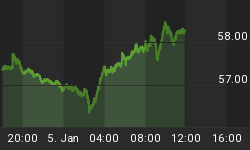The following is excerpted from a commentary originally posted at www.speculative-investor.com on 23rd May 2013.
On the rare occasions when the US stock market crashes, the crash never begins immediately after the price peak. Instead, the ultimate price peak is followed by a process that involves an initial decline (usually 5%-10%), a rebound that retraces 50%-90% of the initial decline, and then a second decline to support defined by the low of the initial decline. This process, or "crash pattern", takes about two months or more to complete. If a crash is going to happen it does so after the price breaks below support defined by the initial low.
It should be understood that the vast majority of "crash patterns" don't actually lead to crashes. A lot of times, support defined by the initial low will not be breached and the "crash pattern" will turn out to be a routine consolidation. Other times, a break below support defined by the initial low will happen without prompting a crash. In the same way that most dogs aren't poodles but for an animal to be a poodle it must first be a dog, most crash patterns don't lead to crashes but for the stock market to crash it must first follow the crash pattern.
The price action of the S&P500 Index during 1987 provides examples of two crash patterns, one of which -- as everyone knows -- ended in a crash, and the other of which turned out to be a routine consolidation. Here's a chart with the crash patterns circled. Also noted on the chart is the test of the low that happened a few weeks after the October crash.

An implication of the above is that even if the US stock market has just hit its ultimate peak, the second half of July would be the earliest that it could crash.
We hasten to point out that a crash is NOT a likely outcome for the US stock market during 2013. As previously advised, our best guess is that the market will make a rounded top over the next 6 months and then roll over into a 1-2 year cyclical bear market. That being said, the combination of the relentless nature of the advance of the past 7 months, the disconnect between earnings growth and share-price growth (the "earnings game" results in the earnings of most companies coming in ahead of expectations every quarter, but the fact is that S&P500 earnings and revenue have barely grown at all over the past 12 months) and the complacent sentiment (the popular view that nothing can go wrong as long as the Fed keeps monetising $85B of bonds per month) makes a crash more likely than it would ordinarily be. First, however, we need a "crash pattern" to form, beginning with a 5-10% pullback.
The crash pattern described above applies to the US stock market and possibly to the stock markets of other developed economies, but it doesn't apply to gold and silver. Gold and silver are quite capable of rocketing up to a major price peak and then immediately crashing, as was seen with both of these metals in January of 1980 and as was seen with silver in April-May of 2011. Also, as per recent experience it is clearly possible for gold and silver to crash after breaking below the bottoms of multi-quarter trading ranges. However, the aftermath of the gold-silver price crash of April-2013 has, to date, been similar to the aftermath of the US stock market's 1987 crash. Of particular note, following gold's April-2013 price crash there was a 2-3 week rebound and then a decline to test the crash low.
We aren't offering a free trial subscription at this time, but free samples of our work (excerpts from our regular commentaries) can be viewed at: http://www.speculative-investor.com/new/freesamples.html
















